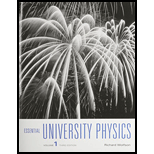
If you push two atoms together to form a molecule, the exclusion principle results in a repulsive interaction between the atoms. How does this repulsion come about?
How does the repulsion as a result of exclusion principle come about between two atoms when they are pushed together to form a molecule.
Answer to Problem 1FTD
The repulsive force according to the exclusion principle results from the overlapping of the electrons belonging to the two atoms.
Explanation of Solution
Pauli Exclusion Principle states that no two electrons in an atom or molecule can have the same four electronic quantum numbers. In other words only two electrons can be in the same orbital of an atom or molecule with one electron having spin up and other having spin down.
Although individual atoms are electrically neutral, the distribution of charge within them gives rise to attractive or repulsive forces. The repulsive force results from the overlapping of the electrons belonging to the two atoms. In accordance with the Exclusion principle, two electrons cannot occupy the same state.
Thus when the atoms are pushed together so that electron wave functions would begin to overlap and occupy the same region of space, the electron clouds of the atoms have to be distorted to avoid the violation of the exclusion principle. This will require energy so that work has to be done in bringing them together which implies there exists a repulsive force.
Conclusion:
Thus the repulsive force according to the exclusion principle results from the overlapping of the electrons belonging to the two atoms.
Want to see more full solutions like this?
Chapter 37 Solutions
Essential University Physics (3rd Edition)
Additional Science Textbook Solutions
College Physics: A Strategic Approach (4th Edition)
Physics for Scientists and Engineers: A Strategic Approach with Modern Physics (4th Edition)
Cosmic Perspective Fundamentals
Essential University Physics: Volume 1 (3rd Edition)
Physics for Scientists and Engineers with Modern Physics
Life in the Universe (4th Edition)
 Physics for Scientists and Engineers with Modern ...PhysicsISBN:9781337553292Author:Raymond A. Serway, John W. JewettPublisher:Cengage Learning
Physics for Scientists and Engineers with Modern ...PhysicsISBN:9781337553292Author:Raymond A. Serway, John W. JewettPublisher:Cengage Learning Modern PhysicsPhysicsISBN:9781111794378Author:Raymond A. Serway, Clement J. Moses, Curt A. MoyerPublisher:Cengage Learning
Modern PhysicsPhysicsISBN:9781111794378Author:Raymond A. Serway, Clement J. Moses, Curt A. MoyerPublisher:Cengage Learning An Introduction to Physical SciencePhysicsISBN:9781305079137Author:James Shipman, Jerry D. Wilson, Charles A. Higgins, Omar TorresPublisher:Cengage Learning
An Introduction to Physical SciencePhysicsISBN:9781305079137Author:James Shipman, Jerry D. Wilson, Charles A. Higgins, Omar TorresPublisher:Cengage Learning
 Stars and Galaxies (MindTap Course List)PhysicsISBN:9781337399944Author:Michael A. SeedsPublisher:Cengage Learning
Stars and Galaxies (MindTap Course List)PhysicsISBN:9781337399944Author:Michael A. SeedsPublisher:Cengage Learning





